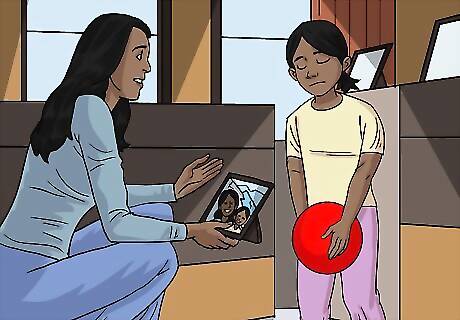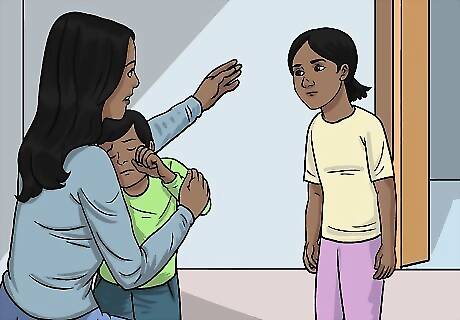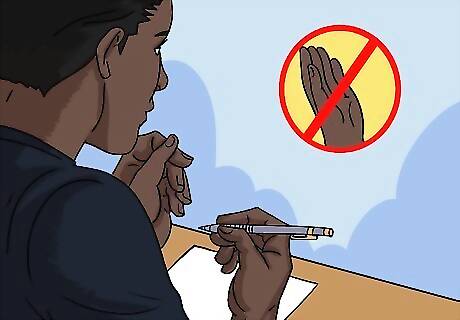
views
Establishing Consequences with Your Child

Let nature take its course. Natural consequences are those that occur as a direct result of the child breaking a rule. You should talk to your child about these consequences and help them make the connection between the cause and effect. With your help, they can process the incident and learn its lessons. In these cases, no parental intervention is required for a child to learn their lesson. Let's say you asked your child not to take their favorite toy out when visiting family. They did and they accidentally left it behind. Not having the toy is the consequence—no further correction is necessary. If the child loses something they care about because they didn’t follow the rules, they are more likely to comply in the future. To cement the lesson, don't turn around to get it or make a special trip. Have the child wait until the next time you visit or teach them problem-solving skills by telling them that they'll need to find a way to get the toy back. Another example is the child hitting a friend and the friend's parent no longer asking them to come over. This outcome teaches the child that hitting is inappropriate and can hinder their friendships.

Link the consequence with the misbehavior whenever possible. Some instances of misbehavior include consequence or restitution as a part of resolving the situation. Logical consequences are those that realistically follow when rules are broken—they should be linked to the misbehavior. In these cases, discipline should come as a direct reflection of their actions. For instance, a child bounces a ball in the house and breaks a picture frame. You might say, “You were asked not to play with the ball inside. Now, you’ve broken a frame. You will have to do extra chores to pay for the frame.” Another repercussion might be, “The money to pay for the frame will be coming out of your allowance.” Be sure to explain why the consequence is being put into place so the child connects the misbehavior with the consequence.

Offer choices to correct undesirable behaviors. Kids like being able to make their own choices because it helps them exercise some level of independence. Choices also help kids learn to gradually develop their own problem-solving skills. Rather than shouting at them for misbehaving, offer clear choices. For example, if a child is hitting others, you might say, “If you cannot keep your hands to yourself, you will have to leave the play area for a time out.” One choice is undesirable (leaving the play area), so the child is more likely to be compliant and make the desirable choice (keep their hands to themselves). Another option might be to say to a child that doesn't want to get dressed, "Would you like to wear the blue shirt or the grey one?" This helps them do the desirable behavior but on their terms.

Correct misbehavior by meeting the underlying need. Pay attention to why your child is acting out. Next, see if you can devise a plan to correct the behavior while helping them get their needs met too. For example, if your child repeatedly interrupts you during an important phone call, they may be desperate for your attention. You might say, “Mommy will be off the phone in a few minutes, then you and I will have some cuddle time, okay?” You might also allow the child to come in the room with you, but only if they play quietly. If your child is running in the house, you might say, “The rule is no running in the house, Jack. How about we go to the playground in the park?”

Create a point system to decrease undesirable behavior. Put a chart up in your home or use a jar to visually represent your child’s behavior. If they misbehave, they may get a point on the chart or a marble goes into the jar. Once they reach a predetermined amount, a consequence is put into place. To have the consequence removed or privileges returned, the child will have to behave appropriately for a set amount of time. This type of discipline allows kids to be able to temper their behaviors to achieve desired results. This is ultimately not getting more points or getting their privileges restored. This same system can be used in reverse to reward good behaviors. Using that approach, the child would earn and lose points according to their behavior. An accumulation of points may lead to a desired activity or treat.
Creating Opportunities for Good Behavior

Use positive reinforcement to increase good behavior. Another effective way to help your child obey is by praising or rewarding them when they are behaving appropriately. When you see your daughter eating her food instead of throwing it, say, “Mindy, I love how you are eating and using good table manners. Keep that up and you’ll earn your favorite dessert!” Experts believe positive reinforcement such as praise and rewards is much more effective than a consequence. Rather than lecturing or withholding privileges when undesirable behavior occurs, they suggest ignoring it and only giving your attention when your child is behaving appropriately. The goal is to get the child to do more positive behaviors to get more attention. This encourages the child to behave well, leaving less opportunity for misbehavior. For example, the parent might ignore it when their child throws food but lay on the praise when they eat as they should.

Set clear rules to help your child know right from wrong. If your child knows and understands what’s expected of them, they are less likely to break the rules. Sit down with your child and explain your family’s rules. Keep the rules clear, simple, and consistent. Also, make them aware of any consequences, such as if rules are broken, gaining points on a chart. When disciplining the child, discuss the rule, its consequence, and how the child can do better. For instance, your rules might sound like, "Walk indoors. No running!" "Complete homework before playtime," or "Clear away your area after an activity, such as homework or arts and crafts." As an example, you might have a rule to treat others with respect. If your child throws a tantrum, you could talk to them about how it's disrespectful for them to behave that way. Then give them an example of how they could express their emotions differently. Post the rules in plain sight, so your child is constantly reminded of how they should behave. Try pinning them to the wall near your points chart (or jar), posting them on the fridge, or hanging a sign up on your kitchen door.

Teach the child how to hold themselves accountable. It's important that your child learn to follow rules even when no one is watching. Resist the urge to micromanage the child's behavior. For example, you could have the child check off positive behaviors, such as doing their homework and cleaning up after themselves. If you have multiple children, teach them to help each other follow the rules, rather than to tattle. For example, if one child notices that the other is running in the house, she could say, "Hey, we're supposed to walk when we're in the house. You could get hurt or break something."

Be consistent across caregivers, situations, and children. Maintain the same rules and the same consequences within your household to help your child establish norms of behavior. That way, they know what to do, and what will happen if they don’t comply. Try to be consistent across contexts and caregivers. For instance, the child shouldn’t be able to break the rules simply because friends are visiting. Similarly, mom shouldn’t have one set of rules while dad has another. You should also have the same expectations for your child even when you are tired. Don't let them use your exhaustion as a free pass to misbehave. In addition, your rules should be consistent between your children—one child shouldn't be allowed to break rules and not have consequences enforced. When other children visit your home, they should follow the same rules as your children. Ask your child to explain the rules to their friends or relatives when they get to your home, as this will help reinforce the child's understanding of the rules.

Provide outlets for them to release energy. Some kids have bucketfuls of energy and they get into trouble because they don’t know how to effectively channel it. Give your child plenty of opportunities to move their bodies and work their minds. They’ll be less likely to misbehave, as a result. Let your child go outside to burn off energy or dedicate a special place inside where they can play. Try keeping fun coloring books, puzzles, and games nearby to keep them preoccupied. Be realistic when it comes to your child. Don’t expect an energetic child to sit quietly for hours at a time. Observe how your child functions and set up parameters that increase their odds of being obedient.
Sticking to Your Plan

Set a firm intention. Make a commitment with yourself that you will use other forms of discipline besides spanking. Lay out a clear plan with alternatives. Focus on this intention daily—write it down and visualize it. For example, you might state, "I will not spank my child. Instead, I will provide choices, use natural/logical consequences, and positive reinforcement to help my child behave appropriately." Having a clear intention for how you want to handle discipline can help you choose a more appropriate technique in the heat of the moment. You might also make your intention public by sharing it with family, friends, and other supportive parents. Ask them to hold you accountable.

Get your partner or co-parent on board. If you’re parenting with someone else, sit down and discuss your intention to not use spankings as a form of discipline. Share what you’ve learned about other, more effective disciplinary techniques. Role-play scenarios and have an open discussion as to how you two can handle common behavioral problems without hitting. If not spanking is a new practice in your household, it may take some time to replace the old habit. Just remind yourselves how damaging spanking can be and make a commitment to turn to other approaches.

Make sure family and friends are enforcing the same rules. Your child is likely going to spend time under the care of other adults, and it's important that they follow through on your rules. For example, if your child is not allowed to play violent video games, then you'll want to ensure that other caregivers don't let them play the games. If the child is able to sometimes break the rules, then it will be harder to achieve the positive behaviors you want. If someone breaks the rules you've set for your child, talk to them about it. If they continue to break the rules, don't let your child go over to their home anymore.

Manage your own stress. Parenting is a challenge, and even the best-laid plans can fall to the wayside when you’re frustrated or upset. Actively manage stress and negative emotions, so that you can think objectively when disciplining. Do relaxation exercises daily, such as deep breathing or progressive muscle relaxation. Eat healthy, nutritious foods that support your health and wellness. Get plenty of rest and exercise, so you can approach discipline with a clear head. Make time for fun activities, like date night or social gatherings with friends and family.



















Comments
0 comment